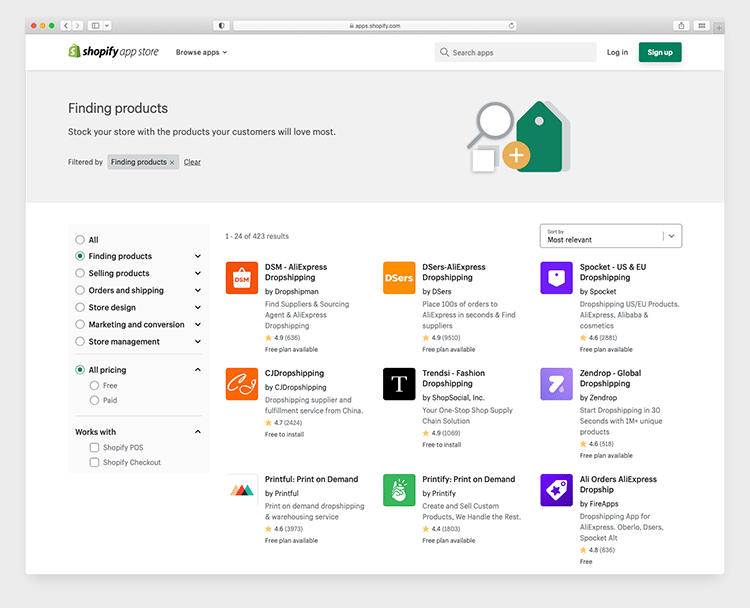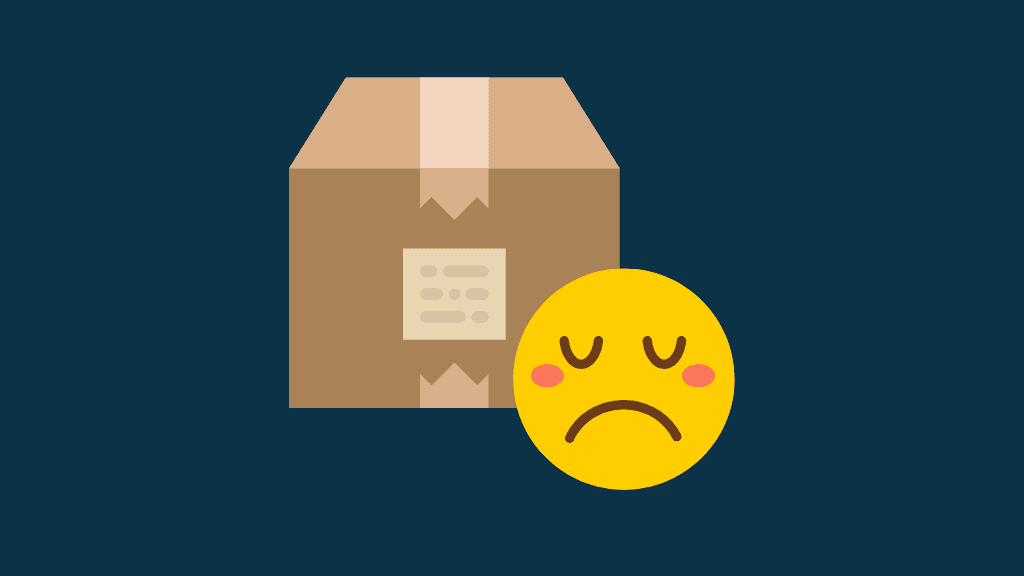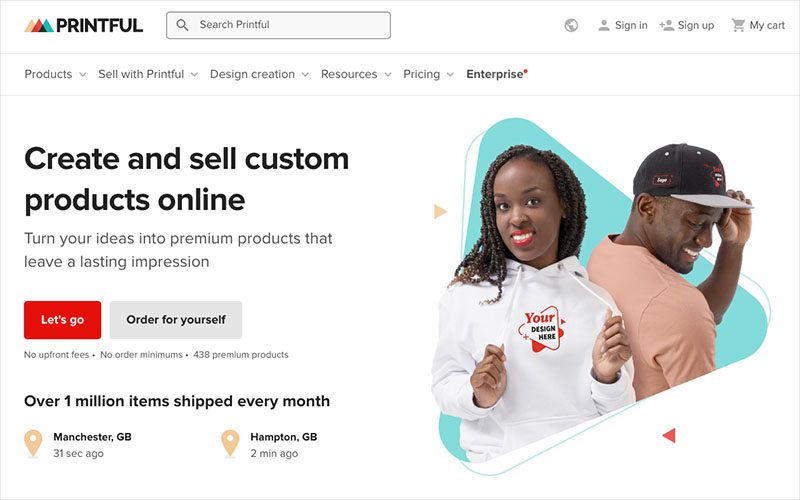
In this guide to dropshipping pros and cons, I’m going to spell out the key reasons you might want to embrace it as a business model, and the reasons why it might not be for you.
Let’s kick things off with a definition of what dropshipping actually is.
Dropshipping definition

Dropshipping is a way of selling online in which you don’t manufacture, purchase, store or deliver any products. Instead, you take orders for products via your online store, and pass them onto a supplier. The supplier sends the goods to the customer — and charges you for doing so (see our video below for an overview of the process).
But should you embrace dropshipping as a business model?
Well, let’s look at the good and bad things about dropshipping and find out.
I’ll start with the good stuff…
The pros of dropshipping

1. Dropshipping gives you a low-cost, low-risk way to start a business
The key advantage of dropshipping as a business model is that you can start doing it extremely cheaply.
To get started, the only thing you need to worry about financially is the monthly fees for an ecommerce platform — and, so long as you choose the right platform, these shouldn’t be too high.
When you dropship goods, you essentially become a ‘middle man,’ marking up on products that you don’t buy or deliver.
And, because you don’t have to really worry about paying for products, staff or storage space, this makes dropshipping a very low-cost, low-risk way to start a business.
2. It lets you sell a really wide range of products
With dropshipping, you can sell pretty much anything you like. A huge number of dropshipping suppliers are available to supply you with a vast number of products — giving you a lot of flexibility regarding the niche you want to dropship in.
By contrast, if you’re making your own products — or sourcing them via local suppliers — you may find it more difficult to operate in some niches (or to give your customers as wide a range of products to choose from).

Working with a dropshiping supplier is usually a simple case of connecting their dropshipping app to your ecommerce platform. Popular apps for selling household goods include DSers and Spocket; alternatively, you can use print-on-demand services like Printful or Printify to sell your own, customized printed products.
📚 Related print-on-demand resources
3. It lets you run a business from anywhere
So long as you have an Internet connection and a computer, you can technically run a dropshipping business from anywhere.

You don’t need to worry about finding a physical location for your business to operate from — something that can take a lot of time and cost a lot of money.
A commute to work can end up as thing of the past too!
4. It doesn’t require a lot of labor
Unlike business models that involve manufacturing your own products — or stocking somebody else’s — dropshipping is not labor intensive.
You generally won’t need to worry about…
- manufacturing
- shipping products
- inventory management.
You will have field to enquiries from customers, and occasionally organize product returns — but overall, the workload involved with dropshipping is very manageable.
5. It’s scalable
With many businesses, you need to invest quite a lot of money in staff, systems and inventory — and sometimes change your operations in very significant ways — to ensure growth.
This is not usually the case with dropshipping — it offers you great scalability. Aside from investing in marketing (and, depending on what you’re selling, keyword research and SEO), you don’t necessarily need to spend much — or change much — to grow a dropshipping business.
Most of a dropshipping business’ infrastructure can more or less stay as it is — it’s just a case of trying to put more orders through it.
6. It’s great for experimenting with
Because the dropshipping business model is relatively risk-free, it gives you a lot of freedom to try things out.
Experimenting with your dropshipping store’s branding, product ranges and approach to online advertising doesn’t really involve much (if any) expenditure.
And, because dropshipping is based around digital technology, you can get a lot of easy-to-access data from these experiments — data that you can use to develop your business with.
Ok, so that all sounded great, didn’t it? But there are some significant downsides to be aware of when it comes to dropshipping.
Let’s go through these now.
The cons of dropshipping

1. Dropshipping profit margins can be low
Because dropshipping is a low-cost, low-risk business model, the barriers to entry are usually very low.
This means that you’ll inevitably find a lot of other merchants entering the dropshipping space, selling the exact same products as you, and competing heavily on price.
And all this puts pressure on you to sell products more cheaply than you’d ideally like to.
2. It’s hard to ensure that your inventory is ethically produced
The advantage of making your own products, or sourcing them locally, is that you can gain a really clear understanding of…
- who made your inventory and
- how it was produced.
With dropshipping however, you’re often in the dark about the working conditions in which your products were made (or who made them).
To make matters worse, many of the dropshipping apps available for the leading online store builders make use of dropshipping companies based in locations where forced labor is not uncommon.
The takeaway here is that if you care about ethics, do some due diligence before committing to a particular supplier.
3. You don’t get much control over branding
With a lot of dropshipped products, you have little control over the appearance of your products — you are generally dealing with ‘off the shelf’ items that lots of other merchants are selling online.
Accordingly, if having a product range featuring your own brand is important to you, then dropshipping is not necessarily for you.
(That said, print-on-demand dropshipping — where you provide designs to companies that use them to produce and ship your goods on a per-order basis — can serve as a workaround here. Print-on-demand companies often take a more ethical approach to product manufacturing, too).

4. Suppliers can be very unreliable
With dropshipping, you’re often relying on suppliers that you don’t know personally, and that you can’t adequately vet.
This can lead to:
- issues with product quality
- bad communication
- products going missing
- low-quality packaging being used.
And all this can result in unhappy customers.
5. Managing multiple suppliers can be difficult
If you’re working with lots of suppliers for your dropshipping business, you can end up with a complicated supply chain.
Different suppliers will have different operational structures in place for backend processes like shipping, processing and billing — and these differing processes can result in some tricky admin for you.
All this can take dropshipping away from being the ‘hassle-free’ business model that made it attractive in the first place.
6. Providing customer support can be difficult
When a dropshipping order goes wrong, good customer service can be difficult to provide.
This is because when a problem crops up, you are often relying on a third-party supplier — who you don’t know and who may be located on the other side of the planet — to solve it.
This can lead to a long wait for a customer who may be puzzled as to why you — as the online store owner — can’t just resolve the issue quickly yourself.
7. Shipping fees can be very high
Depending on where your customer base and suppliers are based, shipping your products may prove expensive.
A lot of dropshipping suppliers are based in China, so if the bulk of your customers are based in the US, they (or you, if you’re offering free shipping) will have to pay a high fee to get their products delivered to them.
8. There are environmental issues to consider
Dropshipping isn’t particularly environmentally friendly.
If your suppliers are based in China (as many big dropshipping suppliers are) and your customers are based in the US or Europe, the delivery process is going to generate a significantly larger carbon footprint than you might like.
So, from an environmental and sustainability point of view, dropshipping isn’t always great.
And that’s that — our take on all the dropshipping pros and cons! Good luck with your dropshipping project should you decide to embark on one.
And if you do, remember that despite its unusual model, a dropshipping business is in many way just like any other — getting one off the ground involves a good business idea, a strong product and a lot of research. You’ll find more information on how to start a business successfully in our startup checklist.
If you’d like to learn more about dropshipping, we have some additional resources available which we’d suggest reading:
- Our introduction to dropshipping with Shopify
- Our guide to selling on Shopify without inventory
- SPOD vs Printful
- How to connect Shopify to Printful
- How to connect Wix to Printful
- Wix versus Shopify vs Squarespace
- Our ‘What is Printful?’ guide
- Our YouTube video guide to dropshipping
- Our YouTube video guide to dropshipping with Shopify
- Our YouTube review of Printful
And finally, if you have any queries about dropshipping, feel free to leave them in the comments.
No comments